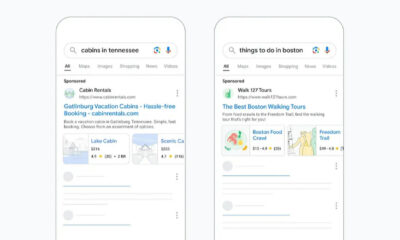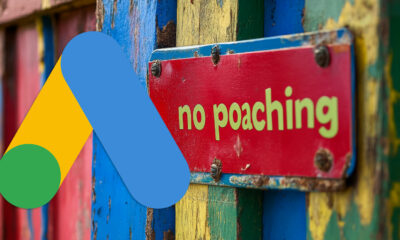SEO
What’s A Good Google Ads CTR/CPC/CPA In 2022? [STUDY]
![What's A Good Google Ads CTR/CPC/CPA In 2022? [STUDY] What's A Good Google Ads CTR/CPC/CPA In 2022? [STUDY]](https://articles.entireweb.com/wp-content/uploads/2022/02/1646039160_Whats-A-Good-Google-Ads-CTRCPCCPA-In-2022-STUDY.png)
“Is this a good click-through rate?”
“Why is our cost per conversion high? Is this in line with our competitors?”
“What’s a good conversion rate?”
How many times do you get asked these questions in a week? A month?
Nothing’s more frustrating than getting these questions from your C-Suite team without having data to back it up. Or, you have outdated data that is not useful in today’s advertising world.
Keeping up-to-date on industry benchmarks is crucial to help answer these questions for your business.
Wordstream by LOCALiQ recently published their Search Advertising benchmarks for 2021.
Their data consists of data points from thousands of campaigns in both Google and Microsoft Ads for the top 20 industries. Some of the top industries include:
- Arts & Entertainment.
- Automotive.
- Education.
- Finance & Insurance.
- Health & Fitness.
- Shopping & Retail.
- Travel.
While these benchmarks are a starting point, it’s important to note that many factors go into setting benchmarks that are attainable for your business.
We hope this data is useful for you to help level-set expectations and goals for your business, as well as get a sense of how you stack up to the competition.
In this report, you’ll find benchmarks for both Search and Display campaigns in Google & Microsoft Ads for:
- Click-through rate (CTR).
- Average cost-per-click (CPC).
- Conversion rate (CVR).
- Cost per acquisition (CPA).
Let’s dig into the data.
Average Click-Through Rate In Google Ads By Industry
The average click-through rate across all industries sat at 3.17% in 2021. In LOCALiQ’s data, the industries they pooled together outperformed that CTR, averaging over 6%.
Compared to when they first started gathering data in 2015, the average CTR for Search Ads was minimal at 1.35%.
The business category that boasted the highest CTR was within Arts & Entertainment with an astounding 10.67% CTR.
At the other end of the spectrum was Attorneys and Legal Services at a 3.84% CTR.
The CTR metric should be analyzed as only one indicator of performance, not the end-all-be-all when trying to determine if your Ads are doing well.
There are many factors that can influence CTR, including:
- Your competition (Is the SERP saturated?).
- Your bid.
- Your position on the page.
- Your ad copy relevancy.
- Your audience targeting.
When analyzing your Ads, Google gives you indicators of performance within your Quality Score. If your average CTR is below your peer set in your industry, Google will let you know.
When optimizing your Search Ads, make sure you’re taking a look at levers outside of just ad copy.
Average Cost-Per-Click In Google Ads By Industry
![What's A Good Google Ads CTR/CPC/CPA In 2022? [STUDY] Average CPC in 2021 by industry.](https://articles.entireweb.com/wp-content/uploads/2022/02/1646039160_815_Whats-A-Good-Google-Ads-CTRCPCCPA-In-2022-STUDY.png) Screenshot from LOCALiQ.com, February 2022
Screenshot from LOCALiQ.com, February 2022While the Attorneys and Legal Services showcased the lowest CTR, they also boasted the highest average CPC. In 2021, the average CPC for this industry came in at $8.67.
This average is not surprising, given the higher than average cost it takes to acquire a customer.
On the lower end of the spectrum, Real Estate and Travel industries had the lowest average CPC at $1.40.
Similar to analyzing the CPC metric, this is just one indicator of performance.
For example, your Ads may show a low average CPC and a low CTR. This could mean that your bids aren’t high enough to be competitive in the market, and you may want to consider raising bids.
On the other hand, if you have a higher than average CPC, you’ll want to monitor these more closely to ensure you can prove your return on ad spend/investment.
Average Conversion Rates In Google Ads By Industry
![What's A Good Google Ads CTR/CPC/CPA In 2022? [STUDY] 2021 average conversion rates across industries.](https://articles.entireweb.com/wp-content/uploads/2022/02/1646039160_505_Whats-A-Good-Google-Ads-CTRCPCCPA-In-2022-STUDY.png) Screenshot from LOCALiQ.com, February 2022
Screenshot from LOCALiQ.com, February 2022The average Conversion Rate is calculated from the number of leads/sales you get divided by the number of clicks from your ad.
When looking at the data from 2021, the average Conversion Rate varied highly across industries.
On the high end of performance, Animals & Pets had the highest conversion rate at 19.19%, followed by Physicians and Surgeons at 19.15%.
The industries that had the lowest Conversion Rate included:
- Furniture: 3.25%
- Real Estate: 3.93%
- Apparel/Fashion & Jewelry: 3.60%
When looking at these industries and the products they sell, these conversion rates make sense.
Furniture is a high-ticket item for many customers. Users do a lot of research online before making a purchase. Not only that, but because of the price tag, many customers end up purchasing in stores instead of online.
While the Conversion Rate may be low on this particular industry, it’s more important than ever to be able to measure offline conversions, such as In-Store visits or purchases.
In the apparel industry, it seems that there are new brands popping up every day.
If you do a simple search for Nike sneakers, the amount of sellers and resellers for these types of products has skyrocketed in recent years.
The simple amount of competition directly attributes to a low (or high) conversion rate.
Average Cost Per Acquisition In Google Ads By Industry
![What's A Good Google Ads CTR/CPC/CPA In 2022? [STUDY] Average cost per lead by industry in 2021.](https://articles.entireweb.com/wp-content/uploads/2022/02/1646039160_720_Whats-A-Good-Google-Ads-CTRCPCCPA-In-2022-STUDY.png) Screenshot from LOCALiQ.com, February 2022
Screenshot from LOCALiQ.com, February 2022The average Cost Per Acquisition is a core KPI that advertisers should keep a pulse on when analyzing performance.
It’s no surprise that certain industries have a much higher CPA compared to other industries. Some of the factors that can influence CPA include:
- Average CPC.
- Average CTR (this influences your CPC).
- Audience targeting.
- Conversion Rate.
- The type of product/service you’re selling.
The Attorneys and Legal Services had the highest CPA out of all industries at a whopping $73.70. This is not surprising considering the possible barriers to entry for this industry.
From a consumer perspective, they are likely doing a lot of research before making a decision and contacting someone in this industry.
While the CPA may be high, many businesses in that industry find that well worth the investment, considering their return on each individual customer.
Those industries that have lower-priced products and services likely have a lower CPA goal. The industries that showed the lowest CPA in 2021 was Animals and Pets at $14.88, followed by Automotive Repair, Services and Parts at $17.81.
Mark Irvine, Director of Paid Search at Search Lab, mentioned that Cost Per Lead metrics showed improvement from recent years. He attributes some of this to the following factors:
- Improvement of Lead Management Systems (CRMs).
- Improvement in audience targeting.
- Improvements in keyword targeting.
Summary
If you find yourself on the lower end of the spectrum in comparison to others in your industry, don’t fret! These benchmarks are meant to be a guidepost for you.
If you’re struggling to improve performance, try following these tips below.
- #1: Set the right (and realistic) goals for your campaigns.
- #2: Test out other search engines besides Google.
- #3: Choose the right budget(s) for your campaigns.
- #4: Invest in a good keyword strategy.
- #5: Focus on your landing page strategy ad optimization.
- #6: Don’t forget about mobile!
Make sure to check out Wordstream by LOCALiQ’s full report on benchmarks and tips to improve your campaigns.
More Resources:
Featured Image: Jirsak/Shutterstock













You must be logged in to post a comment Login